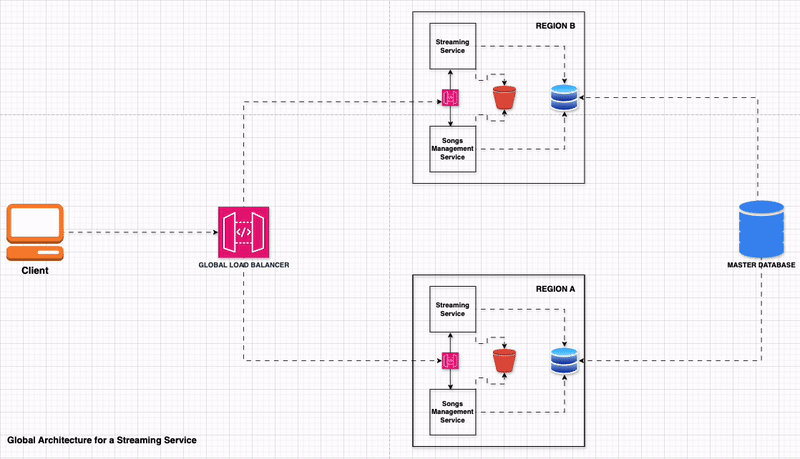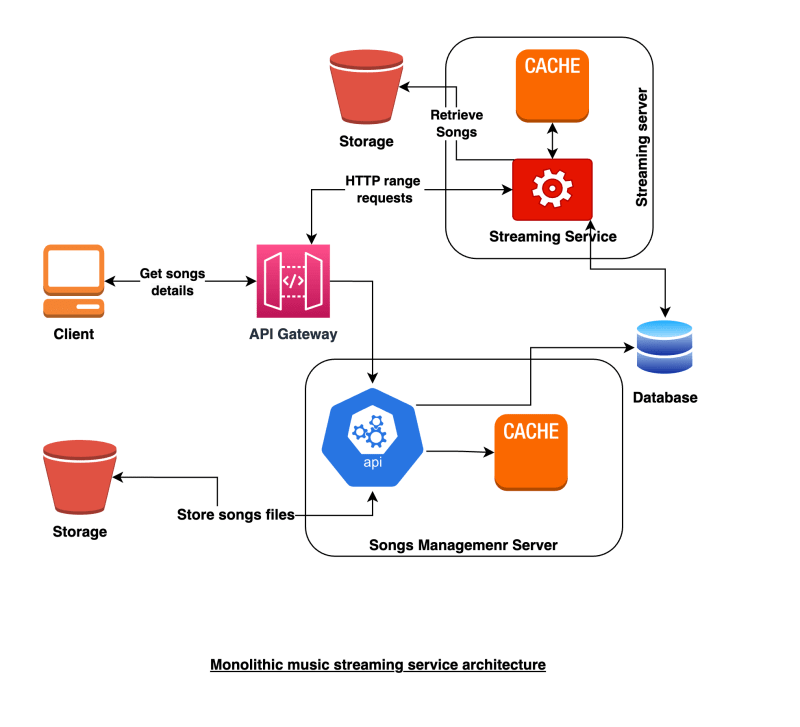😮💨 Building Your Online Presence & Global Music Streaming Architecture
Hi everyone!👋
A few weeks ago, I wrote an article on how to build a music streaming application, and we explored how to design an architecture based on specific requirements.
However, there was a missing piece—what happens if you want to make your application global? 🌍
You’ll need an architecture that not only meets those requirements but also handles logistics 📦, ensures high availability 🔄, and scales efficiently 📈.
Here is what I came up with 👇

Let’s dive in and explain the architecture! 🚀
1. High Capacity and Load Balancing 🏗️⚖️
The architecture is designed to have high capacity to handle the load and distribute traffic across multiple regions. Each region can have multiple instances of servers, load balancers, Redis caches, and other components.
This allows for better traffic distribution to ensure a smooth user experience.
In each region, we have local servers and caches. At the same time, we have a master server that holds all the core data and handles most of the writes. 🔄
This is what an instance of the architecture at a regional view looks like:

2. Replication and Write Mastery 📄💻
In a streaming architecture, we deal with more writes than reads. Why? Because we're streaming music continuously, and it's essential that data is readily available for users.
We have a data replication mechanism between the master server and regional servers. Written data in a region is sent back to the master, but read data is not sent back.
Overall, this improves latency and scalability. If the load becomes too high in a region, we can simply add more instances or even open a new region. 🚀
3. Scalability and Disaster Recovery 📈🛠️
Scalability is crucial for a global architecture. It allows you to support a growing number of users or data without compromising performance. But don’t forget about disaster recovery.
What happens if the master server goes down? 😨 We need to prepare a failover plan to avoid the whole system crashing.
4. Data Consistency and Scalability 📊
Finally, while data consistency could be a challenge in this kind of global architecture, we don't face that problem because data is only read from local regions, and all writes are centralized. This ensures good consistency without sacrificing performance.
Final Thoughts: The Bigger Picture 🌍💥
We’ve built a global streaming architecture that balances scalability, load management, and efficient data handling. 🎉 However, a key point to always remember is to plan for the unexpected.
Beyond just scaling for performance, you’ll need to consider disaster recovery strategies, such as:
• Failover systems: To ensure that if the master server fails, the architecture remains functional.
• Global caching: Incorporating a CDN for media files can reduce latency for large-scale services, improving the user experience.
• Regular backups and monitoring: Keeping an eye on regional performance and server health to prevent system breakdowns.
Globalizing a streaming service is an exciting endeavor, but it requires thoughtful planning around disaster recovery, data replication, and scalability to build a platform that users worldwide can rely on.
Building Your Online Presence as a Developer 🌐
In the next issue, I’ll be sharing my personal story on how Koladev was born and how my online presence has shaped my career.
I’ve spent over five years in software engineering, but what truly opened doors for me was my presence on the internet. From writing articles, sharing insights on LinkedIn and Twitter, and engaging with others in the community—being active online got me noticed.
It led to my first opportunity as a software engineering intern, where I worked on backend development using Django. And it all started because I wrote a Django article that caught someone’s attention.
In the next issue, I’ll dive into how you can build your online presence. Whether you want to go all out across multiple platforms like me or take a more lazy approach, I’ll outline steps for both. Consistency is key, and I’ll share tips on how you can stay active in a way that works for you.
Stay tuned 🔥
Add a comment: